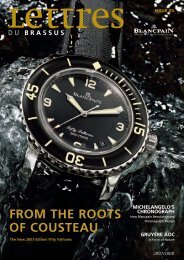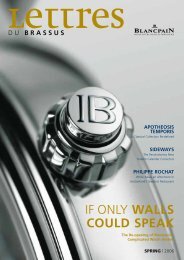THE HISTORY OF BLANCPAIN
THE HISTORY OF BLANCPAIN
THE HISTORY OF BLANCPAIN
You also want an ePaper? Increase the reach of your titles
YUMPU automatically turns print PDFs into web optimized ePapers that Google loves.
IN TIME<br />
Above, Blancpain Rolls<br />
movement; below, Blancpain<br />
Ladybird movement.<br />
<strong>THE</strong> <strong>BLANCPAIN</strong> VILLERET WORKSHOPS CIRCA 1920.<br />
watches featuring a “roue de rencontre”<br />
escapement. Each year until<br />
Villeret’s annexation by France in<br />
1798, a member of the family was<br />
charged with making the selling trip.<br />
The ensuing intervention of the<br />
Napoleonic wars wreaked havoc on the<br />
family business. Although the Blancpains<br />
were able to maintain a degree of continuity<br />
during the wars, the young men of the family<br />
became military conscripts, including<br />
Frédéric-Louis Blancpain who was later to<br />
increase vastly the size of the watchmaking<br />
business and Henri Blancpain, a voluntary<br />
enlistee. A list of conscripts from 1806<br />
shows both how vital watchmaking<br />
was to the economy of Villeret and<br />
how deeply the war reached into<br />
it. Of 78 draftees that year,<br />
46 were watchmakers and 5<br />
engravers compared to but 8<br />
farmers and 8 bookkeepers.<br />
Upon his return from the<br />
Napoleonic conflicts in 1815,<br />
Frédéric-Louis Blancpain utterly<br />
transformed the work of the<br />
atelier. The form of escapement<br />
was modernised from<br />
the roue de rencontre to<br />
the échappement à cylindre.<br />
Establishing a theme that endures<br />
today, nearly two centuries later,<br />
Frédéric-Louis developed ultra flat movements<br />
for his Lépine style watches (Lépine<br />
LO<br />
CT<br />
NU<br />
UT







